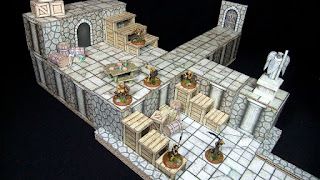The Benefits of Print-and-Paste Terrain
So, when it comes to crafting terrain for tabletop gaming, I'm a big fan of the print and paste method. What I love about it is how straightforward the process is. You're basically using an inkjet printer, some copy paper or cardstock, a sharp knife, and a trusty gluestick. It's this sweet middle ground that's both user-friendly and budget-conscious, without skimping on quality. It's kind of like the crafting equivalent of a one-pot meal – minimal tools but great results.
Now, let’s talk about the aesthetic. When you're working with materials like XPS foam and diving into acrylic painting or airbrushing, there's a steep learning curve. And honestly, the consistency can be hit or miss. But with print and paste, what you see is what you get. The designs you print today will look just as good as the ones you print six months from now. It's like having a reliable recipe that you know will turn out well every time.
This method is especially appealing if you're just getting started or if you're not looking to invest too much time and money into crafting. Plus, there’s a real sense of satisfaction in seeing your gaming world come together with pieces that are both visually cohesive and personal. It’s about finding that perfect balance between quality, speed, and cost – and for me, print and paste terrain crafting hits that sweet spot perfectly.
Crooked Staff #

An absolutely great place to get started is at crooked staff, where Kris Richards publishes amazing textures and extremely creative builds for tiles and scatter terrain. He also has an excellent (and criminally undersubscribed) YouTube channel. His terrain is available (pay-what-you-want) at DriveThruRPG.
- Previous: First Post
- Next: SYWTBAGM Running Sheets

